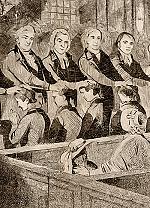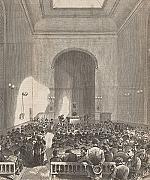Remembering revival

[Above: Johann Valentin Haidt, Arawak Evangelist Jephta, c. 1750. Oil on canvas—Courtesy of Unity Archives, Herrnhut]
The Communion service on August 13, 1727, at the Berthelsdorf Lutheran Church was one of several transformative events that took place that summer among the early residents of the religious community named Herrnhut. This little Pietist group, which would be known in Europe as the Brüdergemeine and among English speakers as the Moravian Church, emerged from this summer with a strong sense of identity, unity, and mission.
That Communion service has become the stuff of legend among missionary-minded and revival-focused evangelicals. A quick online search reveals hundreds of aspirational descriptions of the revival origins of the Moravian movement. If the Moravians once occupied an obscure corner of church history, it would seem this is no longer the case, at least among evangelicals with a bent toward missions and pentecostal experiences.
An Inspiring Narrative
The reasons for this interest in the early Moravians are readily apparent. Eyewitness accounts imbued the events of 1727 with all the marks of evangelical spiritual fervor and special measures of divine grace. Original sources report that love triumphed over division, people prayed a lot, and even children were awakened. The Holy Spirit seemed to be moving. The Herrnhutters quickly began a round-the-clock prayer chain and in a few short years, Moravian missionaries began canvassing the far corners of the globe. It is no wonder that Moravian founder Nicholas Ludwig von Zinzendorf (1700–1760) compared these events to the biblical Pentecost.
While these events solidified the Moravians as a part of revival history, there’s more to the story. As we examine the Moravian tradition, we might ask: how do we celebrate revival stories while recognizing historical complexities?
Evangelical interest in these inspiring events can be traced to the efforts of Moravian evangelist John Greenfield (1865–1941). In 1927 he wrote a small book, Power from on High, to commemorate the 200th anniversary of that famous Communion service. Greenfield hoped to inspire Christians, including his fellow Moravians, to embrace the kind of tabernacle-style revival and mass evangelism that Billy Sunday was then bringing to the revival circuit across America’s cities. Although Greenfield’s book did not convince all of his fellow Moravians, it was immensely successful in introducing the Moravians to Christians across the evangelical spectrum. Greenfield’s narrative has largely remained unchanged as it has been told and retold: a small band of misfits who descended from the persecuted Hussites experienced revival under the leadership of a uniquely pious nobleman, after which a 100-year “prayer meeting” broke out, resulting in missionaries and preachers being sent throughout the world, some of whom converted John Wesley (1703–1791) and influenced George Whitefield (1714–1770). While this simplified narrative is certainly inspiring, there is much more to say about the Moravians and their place in the captivating (and tumultuous) history of revival.
Challenging realities
Modern evangelicals may be surprised to learn that, around the time of their renewal, Moravians were considered the radicals of their day because of their unique and innovative spirituality. In fact many evangelical leaders of the time viewed the Moravians as dangerous heretics of the worst sort. Rival Pietists and other opponents published thousands of pages of slander about Moravian theological and supposed sexual perversions. Revivalist Gilbert Tennent (1703–1764) once declared that he would give his last drop of blood in the effort to stop the spread of the Moravians and their heresies. And although it is true that Wesley and Whitefield were at first absolutely infatuated with the Moravians, these relationships soured. Both joined the chorus of voices condemning what they saw as theological errors among the early Moravians.
Moravians were undeterred by all this controversy, however, and succeeded in building a dynamic culture of spirituality that continued through subsequent centuries. In fact they constructed a tradition that far eclipsed the events of that summer in 1727. Among the congregations and communities Moravians established throughout the world, this spiritual culture sometimes included alternative patterns of life, where individuals might live in large shared houses rather than with their families. An especially important part of Moravian spirituality was their innovative worship. They composed hymns, set aside regular “singing hours,” and became well known for their musical virtuosity, especially during holiday worship. Moravians wrote new liturgies that reflected their Christocentric Pietism and crafted catechisms to instruct new converts.
This spiritual culture placed a high importance on prayer. “Hourly intercession,” the practice that has received so much attention by those leading the modern “24/7” prayer movement, began within weeks of the 1727 renewal, with volunteers organized to pray individually during hourly time slots. According to the Herrnhut diary, the reason for this special prayer effort was not specifically to inspire missions, but rather to defend and guard the young community from satanic influences (by which they may have meant local opposition parties).
Although the nonstop prayer meeting is sometimes portrayed as a centralized practice that lasted for more than a century, it is difficult to know how successful it was. Throughout the decades, as the practice was replicated in new congregations, it would have become decentralized. It is likely that many individuals were praying at once among various congregations, and at other times, especially during night hours, there were gaps in the chain. In any case the practice was officially discontinued in 1818—nine years short of a century, but impressive nonetheless. Of course Moravians didn’t stop praying in 1818. In fact they revived the hourly intercession in 1957 as part of the 500th anniversary of the founding of their predecessor group, the United Brethren, in the old regions of Moravia, and it continues to be practiced among many Moravian congregations today.
Another notable part of the spiritual tradition of the Moravians has been their ability to replicate themselves and their communities, which nineteenth-century Moravians called “diaspora work.” From the start of their renewal movement at Herrnhut, Moravians developed a systematic approach that fit the different places they worked. For instance, even in the eighteenth century, they fostered grassroots connections in Europe and England among other Christians who embraced a Pietist or “awakening” orientation. They also used Zinzendorf’s political connections to establish religious societies made up from the various existing Christian churches.
Wherever they went Moravians often found themselves embroiled in the difficult political realities of empire. In the Caribbean, Moravians set up mission stations within the plantation societies and established new congregations among the enslaved. They even purchased a plantation, along with its enslaved laborers, which of course raises uncomfortable moral questions. In Greenland Moravians established churches among indigenous communities and became early linguists and ethnographers. Similar work continued among indigenous communities in the Americas.
Among the colonial populations in North America, Moravians created travel networks that expanded outward from Bethlehem in Pennsylvania and from Salem in the Carolinas. These networks established preaching stations or small societies, some of which later grew into congregations. In turn some of these grew into structured religious towns. Missionaries who went to remote parts of the world or foreign climates faced physical hardship and sacrificed greatly, even accepting the possibility of their deaths—something that has contributed to their legendary status among evangelicals.
In establishing these outposts, Moravians maintained and fostered a sense of global interconnectedness as a worldwide community of the awakened. They constructed a culture of journaling and correspondence that encouraged anyone who was involved in travel or missionary work to send regular reports back to their sending congregations. These reports were often copied, transcribed and/or translated as needed, and then circulated through their international network. Moravian ministers would often read these reports to their churches during special “congregation days.” In this way Moravians could see themselves as part of a global community as they celebrated the work of their members and incorporated mission efforts into their prayer lives. Thus the Moravians were instrumental in helping to construct the sort of missionary infrastructure many twenty-first-century Christians take for granted.
Shedding controversy
After the death of Zinzendorf in 1760 and over the course of the nineteenth century, Moravians shed their controversial reputation. Moravian mission reports were published in evangelical periodicals and read by non-Moravians. Many began to see the Moravians not as dangerous heretics, but as heroic saints rising from humble beginnings. At times this enthusiasm for the Moravians has led some to claim that Moravian missionaries packed their own headstones and coffins or sold themselves into slavery. Although one early Moravian expressed willingness to become a slave to evangelize the enslaved, claims such as these are exaggerated.
Over the centuries, as their church became a more mainstream denomination, Moravians have had differing perspectives on their revival history. Some, like Greenfield, worked to reawaken their revival heritage, while other Moravians (especially in Europe) have been reticent to embrace revivalism, seeing it as an extension of American religious trends.
The Moravian spiritual tradition consists of much more than the revival event that took place 300 years ago at the little church in Berthelsdorf, and the larger story of this heritage is a fascinating case study in the messiness of revival history and memory. Regardless of these historical complexities, however, the revival ideal, which links special movements of divine grace, prayer, outpourings of the Holy Spirit, and a resulting witness of expansion and renewal, remains for many a compelling part of the Moravian tradition. CH
By Jared S. Burkholder
[Christian History originally published this article in Christian History Issue #153 in 2024]
Jared S. Burkholder is a scholar of Moravian history and program director for history and political science at Grace College.Next articles
Support us
Christian History Institute (CHI) is a non-profit Pennsylvania corporation founded in 1982. Your donations support the continuation of this ministry
Donate







